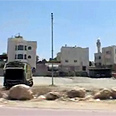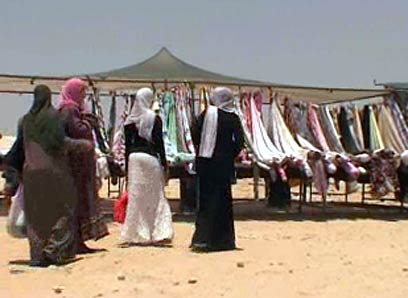
Rahat
צילום: שי רוזנצוויג
A Bedouin welcome
A visit to the city of Rahat acquaints us with the heavy desert heat. Tourism in the city appears to be a story of a lot of good will and few resources, which creates pretty good results: a colorful market, a peace tent, a future museum and more
A visit to Rahat on a weekday afternoon acquaints us with the heavy desert heat. Rahat is the largest of the seven permanent settlements in the Negev settled by the Bedouin. The city sprawls over a large area relative to the number of inhabitants, and the scenery includes low buildings, with eight or nine mosques standing out. The further you delve into Rahat and its neighborhoods, the more inner contradictions you will uncover.
So simple, yet so complex
When it was built in the early Seventies, Rahat was divided into 32 neighborhoods that were designated for an equal number of clans. Excluding a new and mixed neighborhood that is in the process of being built, the residents of Rahat continue to live in the same fashion. Between every neighborhood there is a dividing road or wadi. It is interesting to see that the shutters on the houses on the borders of the neighborhood are always shut. “It is intended to protect the honor of the woman,” explains Tomer Cahana, who accompanied us on our tour, “so that men from a different clan will not see a foreign woman in her house”. Even though the point was clear, the word “honor” did not really seem appropriate to me in this context. We continue.Tomer directs our attention to some of the yards of the houses, where there are occasionally entire flocks of sheep. “People who lived with their flocks inside their tents, were forced to bring their flocks into their homes. A situation was created whereupon Rahat is not exactly a city or a village and also not a tent. Try to figure out what it is.”
From the laws of the desert to municipal life
The Bedouin population in the Negev numbers around 160,000 people. Half of them live in towns that were built for them, and the other half is spread out through the area - in what are known as “unrecognized villages”.After years of wandering and living according to desert laws, the Bedouin were settled - some willingly and some because they had no choice. The move to urban settlements set a few processes in motion, which influenced the Bedouin sector, and radicalized their situation.
In the urban settlements there is no opportunity to continue traditional agriculture, mostly raising sheep and working the land for personal consumption. Therefore, thousands of families, who were not able to adapt to an urban lifestyle, find it difficult to sustain themselves with dignity. Unemployment is on the rise, as is crime and violence. The difficult economic situation and embitterment lead to demoralization and religious and political extremism.
The State of Israel, which concerned itself with settling the Bedouin in permanent homes, did not concern itself with helping them continue on this road. Not with appropriate infrastructure, nor with preparing the Bedouin for alternative livelihoods. The tourism branch is an example, one of many, of the unrealized potential that is hidden in Rahat and in other Bedouin villages.

The market in Rahat
Bedouin tourism: There is such a thing
Seven years ago Tomer Cahana became interested in developing tourism in the Bedouin sector in the Negev. He based this vision on the ethnicity, and on the famous ethos of welcoming guests that is customary in this sector.Together with Sefi Hanegbi, Cahana conducted tests on the feasibility of opening a branch of tourism in this sector. The results of the tests revealed a great potential, and thus they recruited the Department of Tourism, the Jewish Agency, the Negev Development Authority, and the Office for the Development of the Negev and Galil, who began to invest in creating a new venture - Bedouin tourism.
In the framework of this development many hours of consultation were allocated to Bedouin entrepreneurs with potential and to the local Bedouin authorities. They prepared business plans, and master plans to develop tourism in the communities of Rahat, Segev Shalom, Hura, Kuseife, and in the regional council of Abu Basma that has 11 unrecognized villages in its area.
If it is not a tent it must be a palace
At the edge of Rahat we meet Ahmed El Huzeil, the son of Sheik Salman El Huzeil the second. The famous sheik served as the grand arbitrator for years for the Bedouins of the Negev and the Bedouins who lived in the north, as well as Egypt and Jordan. Ahmed shows us the house where he grew up, the “Sheik’s palace”. It is an abandoned and crumbling three-story stone building, which was built at the beginning of the twentieth century. “This was the first building in the Negev”, says El Huzeil. “To the Bedouins who were living in tents it looked like a palace, and that is how the house got its name”.Sheik Salman El Huzeil the second had 39 wives (each time he married one woman, he would divorce the previous wife). Ahmed is the oldest son of the thirty-ninth wife. By the way, the sheik lived with her for over thirty years.
The Sheik’s palace is planning to undergo renovations soon, and will become a heritage museum for the El Huzeil tribe and Bedouin culture in general. Nevertheless, it already serves as a drawing point to visitors who are interested in getting a close look at the history of this family and the area.
Half off
We left the palace and made our way to the Rahat market, without a doubt the beating heart of the city, which offers nearly everything: food and drink, vegetables, spices, clothing, shoes, toys, handicrafts, music and perfumes. Corresponding to the character of the city, that seems to have stopped in time, the prices also seem from long ago.While we were wandering around the market, we received a call from Ibrahim Al-Fineesh, the owner of the Peace Tent which is located right outside Rahat. We stopped our shopping expedition and went to him.
On the way to Eilat
It is difficult to describe the unique atmosphere of the authentic Bedouin tent. Maybe it is the kitten who does not leave his owner for a second, or maybe it is the musician, the singer and her voice which reside in the tent, or Ibrahim’s wife, who after he explains to us at length that she is forbidden to come to the men’s side, she bursts in full of smiles (“Fine, if it is Jews then it is OK,” Ibrahim gives as an excuse).A few years ago Ibrahim sold his tow truck, which was his livelihood for many years and bought this tent in Jordan, so that he can host whoever would like to come.
“The whole story of the tent began when I came to tow a (Jewish) family whose car broke down on the way to Eilat” Ibrahim explains to us the chain of events. “I saw the disappointment in their son’s eyes that the family would not be able to make their vacation in Eilat, so I lent them my car”. The rest, as they say, is history. “Ever since then we have been closer than brothers”, he retells, and “thus we decided to set up a tent that would spread the message of peace”.
On the way home Tomer asks me if I think there is tourism in Rahat. “There is what to improve”, I answer him, but in fact Rahat has everything: it has interest, it has culture, it has history and interesting people. It is possible that you just need a little patience for it to be ready.
Tomer Cahana, group tours: 054-4925888.










